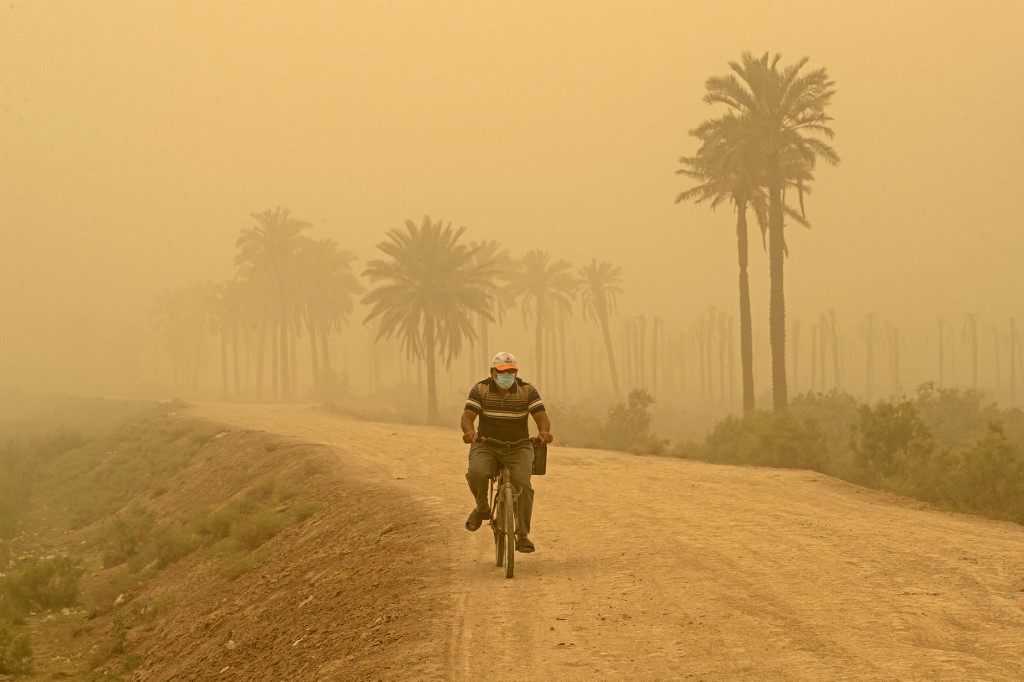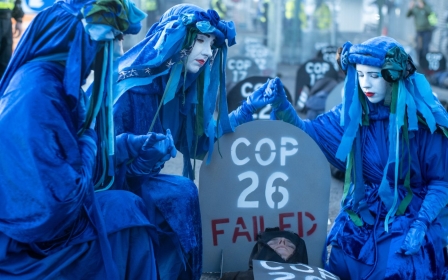Iraq sandstorms: The dual threat of climate change and bad governance

The recent sandstorms that have swept across Iraq portend a troubling future for the nation and the rest of the region. While they are a natural phenomena exacerbated by climate change, they are becoming more intense due to poor policies managing water and green spaces - a failure of Iraqi governance since the 2003 war.
These sandstorms serve as a reminder for multilateral organisations, such as the UN, along with regional NGOs and local Iraqi leaders, that national, regional and environmental security intersect. It is time to acknowledge this precarious confluence and the new security dilemmas, such as climate refugees, that will emerge as a result of desertification.
The legacy of former president Saddam Hussein's political ecology left Iraq particularly vulnerable to climate change
Indeed, these latest sandstorms, painting the skies of Iraq in persistent hues of orange and ochre, illustrate both its and the Middle East’s future in the Anthropocene epoch.
To give you an idea of what a sandstorm is like, imagine it is 4pm, and the sky is completely clear on an April day in Kazimiyya, a district on the outskirts of Baghdad. Within the span of a few minutes, the sky is obscured by haze and day turns into night.
It is not like in the movies, where you are covered by a mound of sand within seconds. A fine dust cloud, almost invisible, pervades the air, and sand granules enter your mouth and nose. They pass through what you are wearing, covering your body from head to toe. Twenty minutes later, the storm has passed and the sky is clear again.
Sandstorms proved to be a crucial weapon during the 2003 Iraq War, delaying the US military from advancing on the capital.
Accelerated desertification
Today, the sandstorms are more frequent and more persistent, shutting down air traffic and leading to hospitalisations. The storms are expected to grow even more intense amid higher temperatures and irregular rainfall, leading to more droughts. The rapid drying out of the land leads to soil degradation and accelerates desertification, contributing to yet more sandstorms.
Azzam Alwash, a prominent Iraqi environmentalist, also attributes the increasing sandstorms to desertification resulting from rising water salinity. In Iraq, sea-level rise has led to saltwater intrusion in Basra’s canals and streams, 300km upwards through the Shatt al-Arab waterway, killing crops, livestock and fish.
To make matters worse, the legacy of former president Saddam Hussein’s political ecology left Iraq particularly vulnerable to climate change.
Saddam commanded the draining of the southern marshes in the 1990s, after the area became the site of an antigovernment uprising. Even with attempts to restore the marshes, Saddam’s actions left a legacy that made it easier for saltwater intrusion from the Gulf to Basra. The basins of dried-up bodies of water provide the fodder for even more dust storms.
Atmospheric chemist Paul Crutzen coined the term Anthropocene to refer to the most recent period in human history, following the Industrial Revolution, when human activity has begun to have a fundamental and detrimental impact on the Earth.
Under this scenario, the trajectory of modernity threatens nature, creating risks that undermine modern society. The Middle East faces a particular risk during the Anthropocene.
In recent years, areas in the Gulf and Iraq have endured some of the hottest temperatures ever recorded in the planet’s history. In the future, cities such as Basra and Baghdad may witness a form of “climate apartheid,” where only the wealthy, with access to reliable electricity, will be able to afford air conditioning to endure the heat.
In Iraq, environmental collapse will exacerbate food and water insecurity, further undermining the country’s precarious national security situation. In Basra, mass protests have erupted repeatedly in the past few years over unreliable water services, leading to clashes with government security forces and Iraqi militias.
Mismanaged resources
Although the Tigris and Euphrates rivers run through Iraq, it is classified as one of the five countries most vulnerable to climate change and desertification in the world.
A combination of factors can exacerbate domestic security when climate disruptions occur. Nations with a history of conflict, agricultural dependence, water deficits and political exclusion, where ethnic or religious groups have no representation in government, are prone to instability due to climate change.In the Middle East, Iraq, Syria, Libya and Yemen meet all of these conditions.
Climate change is just one driver of Iraq’s sandstorms. Poor environmental policies are another. The Iraqi state has mismanaged water resources by failing to curb inappropriate farming practices and rapidly depleting groundwater resources, which dries up the land. Iraq’s Ministry of Water Resources has also suffered budget cuts.
While sustainable environmental programmes will have to occur at a multilateral level, the Iraqi state can at least adopt policies to mitigate the impacts of climate fluctuations, particularly on vulnerable populations such as the Bedouin. Lamentably, Iraq has yet to form a government since its October 2021 elections to deal with this problem.
Ultimately, national governments in the region and collective bodies, such as the UN or the Arab League, need to develop anthropogenic security strategies, reimagining droughts exacerbated by climate change as transnational environmental risks. This requires nations and collective security institutions to adapt to risks that do not emanate from state or non-state actors.
Ironically, modern-day Iraq corresponds to the historic Fertile Crescent, where civilisation first began due to optimal climate conditions. Tragically, civilisation may first begin to unravel there as well, due to our modern society’s impact on the climate.
The views expressed in this article belong to the author and do not necessarily reflect the editorial policy of Middle East Eye.
This article is available in French on Middle East Eye French edition.
Middle East Eye propose une couverture et une analyse indépendantes et incomparables du Moyen-Orient, de l’Afrique du Nord et d’autres régions du monde. Pour en savoir plus sur la reprise de ce contenu et les frais qui s’appliquent, veuillez remplir ce formulaire [en anglais]. Pour en savoir plus sur MEE, cliquez ici [en anglais].







